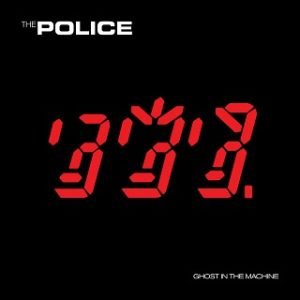When Ghost in the Machine was released in October 1981, it marked a turning point for The Police, both musically and thematically. Nestled between the raw energy of 1980’s Zenyatta Mondatta and the chart-topping masterpiece Synchronicity of 1983, this album signaled a bold evolution in the band’s sound. By embracing synthesizers and an expanded sonic palette, Ghost in the Machine offered a departure from the minimalist, reggae-infused post-punk that had defined their earlier work. The album showcased a willingness to experiment, foreshadowing the creative ambition that would later define their legacy.
The Police sought to capture this concept by weaving introspective lyrics with innovative production techniques. With Hugh Padgham at the production helm, the trio—Sting, Andy Summers, and Stewart Copeland—crafted an album that fused their trademark sound with lush horns, layered keyboards, and a darker, more brooding tone. The result was a body of work that pushed the boundaries of their artistry while mirroring the existential anxieties of a rapidly changing world.
This artistic pivot wasn’t just an attempt to modernize; it was an assertion of The Police’s role as trailblazers in the early ‘80s music landscape. As bands like Talking Heads and Japan began experimenting with synthesizers and electronic textures, Ghost in the Machine positioned The Police not only as part of this wave but also as innovators who could integrate complexity into accessible pop-rock. It’s an album that dares to ask probing questions about identity, communication, and our increasingly mechanized existence—offering as much intellectual substance as musical evolution.
Sonic Exploration

Ghost in the Machine stands as a testament to The Police’s commitment to evolving their sonic identity. Under Hugh Padgham’s meticulous production, the album boasts a polished, almost cinematic quality that was a significant step forward from the rawer textures of their earlier records. Padgham’s crisp engineering captures the intricate interplay between the band’s instruments while layering in synthesizers, horns, and effects that enhance the album’s futuristic and introspective themes. The production feels expansive yet intimate, mirroring the existential weight of the album’s lyrics.
Musical Arrangements
The musical arrangements are some of the most adventurous in the band’s catalog. Sting’s iconic basslines—fluid, melodic, and hypnotic—anchor the tracks while giving ample room for experimentation. Andy Summers’ guitar work balances minimalist textures with ethereal, shimmering tones, often stepping back to let atmospheric synth lines take center stage. Stewart Copeland’s drumming is, as always, both precise and dynamic, but on this album, he often complements the mood rather than dominating the rhythm section, allowing for a richer, more layered sound. Adding horns—played by Sting and session musicians like Dick Morrissey—was an inspired choice, injecting tracks like “Demolition Man” and “Hungry for You” with jazzy, brassy energy that broadens the album’s scope.
Genre Elements
Genre-wise, Ghost in the Machine is a kaleidoscope of influences. While the band retains their post-punk and reggae roots, they also explore new wave, jazz, and synth-pop in ways that feel both organic and daring. Tracks like “Spirits in the Material World” and “Every Little Thing She Does Is Magic” lean into buoyant, radio-friendly melodies, while darker cuts such as “Invisible Sun” and “Darkness” exude a haunting quality that nods to the growing influence of electronic and ambient music in the early ‘80s. By blending genres so seamlessly, The Police created a soundscape that was both accessible and thought-provoking, bridging the gap between the danceable rhythms of pop and the cerebral undertones of progressive rock.
Lyrical Analysis

At its core, Ghost in the Machine is an album steeped in existential themes, with lyrics that probe humanity’s struggle for meaning in an increasingly mechanized and disconnected world. Sting, the primary lyricist, draws heavily from Arthur Koestler’s writings, channeling the author’s concerns about the dehumanizing effects of technology and bureaucracy. This sense of alienation and yearning pervades the album, creating a unified lyrical narrative that feels as urgent today as it did in 1981.
Themes
The central themes revolve around isolation, the search for identity, and the breakdown of communication. Songs like “Spirits in the Material World” question the efficacy of political systems, with Sting lamenting, “There is no political solution / To our troubled evolution.” It’s a cry against institutional failure, underscoring the need for personal and spiritual awakening in the face of societal malaise. Similarly, “Invisible Sun” explores resilience amid despair, inspired by the conflict in Northern Ireland, with evocative imagery like “There has to be an invisible sun/ that gives us hope when the whole day’s done.” The recurring motifs of light and darkness, physicality and spirit, mirror the album’s tension between hope and disillusionment.
Lyrically, Ghost in the Machine strikes a balance between the poetic and the straightforward. Sting’s words are often rich in metaphor, offering layers of meaning without veering into the overly abstract. For instance, the playful “Every Little Thing She Does Is Magic” juxtaposes its upbeat melody with lyrics about unrequited love and emotional vulnerability, while “Omega Man” delivers its dystopian narrative with a clear, almost cinematic approach. This duality—accessible yet deep—gives the album a broad emotional range, allowing listeners to engage on both intellectual and visceral levels.
Emotional Impact
The emotional impact of the lyrics is profound. They evoke introspection and a sense of urgency, urging the listener to confront personal and collective anxieties. Tracks like “Darkness” delve into introspective loneliness, with lines like “I wish I never woke up this morning / Life was easy when it was boring” conveying an almost claustrophobic despair. Yet, the album isn’t without its moments of warmth and uplift. The exuberance of “Every Little Thing She Does Is Magic” offers a counterpoint to the heavier themes, reminding us of love’s power to cut through even the bleakest existential musings.
Cohesion and Flow

One of the defining strengths of Ghost in the Machine is its remarkable cohesion, both in musicality and thematic intent. The album’s progression feels deliberate, guiding the listener through a sonic and emotional narrative that mirrors its philosophical underpinnings. Tracks transition fluidly, creating a sense of movement that’s as much intellectual as it is musical.
Track Progression
The album opens with “Spirits in the Material World,” an immediate statement of purpose that sets the tone with its reggae-inspired rhythm, sharp lyrics, and pulsing synths. This track establishes the core themes of disconnection and societal critique, which ripple through the subsequent songs. As the album unfolds, it alternates between urgent, rhythmically propulsive tracks like “Demolition Man” and more introspective moments such as “Invisible Sun,” maintaining a balance that keeps the listener engaged.
There’s a subtle emotional arc woven into the track progression. Early tracks, like “Every Little Thing She Does Is Magic,” offer lighter, more buoyant moments, while later cuts, such as “Darkness,” delve into deeper, more introspective territory. This shift mirrors the album’s thematic exploration of humanity’s complex relationship with technology and modernity—starting with an outward critique and gradually turning inward to explore personal alienation.
Thematic Consistency
Thematic consistency is a hallmark of the album. From the politically charged “Too Much Information” to the existential musings of “Secret Journey,” the songs feel unified in their focus on the human condition. Even the stylistic diversity—spanning reggae, new wave, jazz, and synth-pop—feels intentional rather than disjointed. The horn arrangements, ethereal synthesizers, and layered production create a sonic thread that ties the album together, ensuring that even the most genre-bending moments serve the overarching narrative.
Occasionally, the album’s flow challenges traditional notions of cohesion by introducing unexpected shifts, such as the brassy exuberance of “Hungry for You” amidst darker songs. However, rather than jarring, these moments feel like dynamic punctuation marks, emphasizing the complexities and dualities of the themes at play. These contrasts enrich the album’s tapestry, reflecting the oscillation between hope and despair, connection and isolation.
Standout Tracks and Moments
Though Ghost in the Machine shines as a cohesive album, several tracks stand out for their artistic brilliance, innovation, and emotional resonance. These songs, alongside specific moments within them, encapsulate the creative heights The Police achieved in this era of experimentation.
Key Tracks
“Spirits in the Material World”
As the album’s opener, this track is a thematic and sonic thesis statement. Its reggae-infused rhythm is juxtaposed with an otherworldly synth melody, creating a sense of unease that mirrors the song’s critique of political ineffectiveness. The infectious groove, combined with Sting’s philosophical lyrics, makes it a standout piece that hooks listeners immediately.
“Every Little Thing She Does Is Magic”
Perhaps the album’s most accessible and joyous track, this song is a masterclass in blending emotional vulnerability with pop sensibility. Its buoyant piano riff and soaring chorus offer a burst of light amidst the album’s darker themes. The genuine, almost awkward charm in Sting’s delivery of the lyrics adds an emotional depth that elevates the track beyond a simple love song.
“Invisible Sun”
This haunting and introspective song stands out for its emotional weight and understated power. Inspired by the conflict in Northern Ireland, its brooding synth-driven arrangement conveys both despair and resilience. Sting’s delivery of lines like “There has to be an invisible sun / That gives us hope when the whole day’s done” is poignant, offering a rare moment of fragile optimism.
“Demolition Man”
With its driving bassline, aggressive horns, and relentless energy, this track is a force of nature. Sting’s snarling vocals and the song’s unrelenting rhythm make it one of the band’s most electrifying performances. Later covered by Grace Jones, the song’s swagger and intensity make it a standout on an album already brimming with dynamic moments.
Memorable Moments
The Horns in “Hungry for You”
While the lyrics, sung in French, are playful and seductive, the brass arrangements elevate the track with an exuberant, jazzy energy. This moment highlights the band’s ability to seamlessly integrate unexpected elements without losing their identity.
The Outro of “Every Little Thing She Does Is Magic”
The jubilant climax of this song, with layers of instrumentation building into an almost chaotic celebration, is a testament to the band’s knack for crafting moments that feel spontaneous yet meticulously arranged.
The Instrumental Layers in “Invisible Sun”
The gradual layering of ambient synths, a steady drum machine-like rhythm, and Sting’s ethereal vocal delivery create an atmospheric masterpiece. The restrained arrangement draws the listener into the song’s introspective heart, proving that subtlety can be just as powerful as bombast.
Stewart Copeland’s Drum Work on “One World (Not Three)”
This track showcases Copeland’s rhythmic genius, blending reggae-inspired beats with intricate fills that propel the song forward. His drumming is both technically brilliant and perfectly in tune with the album’s themes of unity and division.
The Brooding Close of “Darkness”
Andy Summers’ minimalist guitar lines and Sting’s reflective lyrics create a haunting conclusion to the album. The sparse arrangement and introspective tone perfectly encapsulate the album’s exploration of alienation and self-discovery.
Artistic Contribution and Innovation

When Ghost in the Machine arrived in 1981, it secured The Police’s position as one of the most forward-thinking bands of their time. While they were initially grouped with post-punk and new wave peers like Talking Heads and The Clash, this album demonstrated a willingness to venture beyond genre boundaries, pushing the limits of what was expected in the early 1980s. By blending new technologies, diverse musical influences, and introspective themes, Ghost in the Machine redefined the contours of new wave and pop-rock, solidifying its place as a landmark in both genres.
Pushing Boundaries in Genre and Industry
In an era dominated by guitar-driven rock and the nascent rise of synth-pop, The Police struck a unique balance. They retained their reggae-inspired rhythms and rock energy while incorporating synthesizers, horns, and ambient textures—elements that were still relatively underexplored in mainstream rock. Ghost in the Machine blurred the lines between genres, bridging post-punk, new wave, and progressive rock. Its willingness to experiment mirrored the broader shift in the music industry, where artists were beginning to embrace the possibilities of new technology.
The album also elevated the thematic scope of pop music, tackling weighty subjects like political disillusionment, human alienation, and existential longing. While other artists of the time addressed similar themes, The Police’s ability to pair them with accessible melodies and innovative arrangements allowed Ghost in the Machine to resonate with both mainstream audiences and critics alike.
Innovative Aspects of the Album
Production Techniques
Under Hugh Padgham’s guidance, Ghost in the Machine became a masterclass in production. The introduction of layered synthesizers, alongside The Police’s characteristic stripped-down sound, added a lush, atmospheric quality that was groundbreaking for the band. The use of digital effects and mixing techniques gave the album a clarity and depth that pushed rock production into a more polished, futuristic realm without losing its emotional immediacy.
Integration of Horns and Synths
The Police’s use of horns on tracks like “Demolition Man” and “Hungry for You” marked a significant shift for a band previously defined by their trio dynamic. These elements didn’t just add texture—they expanded the emotional range of the music. Similarly, synthesizers weren’t used merely as embellishments but as integral components of the album’s soundscape, particularly in tracks like “Spirits in the Material World” and “Invisible Sun.”
Thematic Ambition
While many albums of the time explored personal relationships or political rebellion, Ghost in the Machine approached these topics through a philosophical lens, drawing inspiration from literature and existential thought. Its central preoccupation with the effects of technology and bureaucracy on human connection felt particularly prescient in the burgeoning digital age, making it both a product of its time and a forward-looking work.
Sophisticated Song Structures
The band moved beyond traditional verse-chorus-verse structures, crafting songs that often felt more like dynamic journeys. This approach is especially evident in tracks like “Omega Man” and “Darkness,” where shifts in tone and texture enhance the narrative and emotional weight of the music.
Closing Thoughts

Ghost in the Machine is a daring and transformative album that exemplifies The Police’s willingness to push their creative boundaries. With its polished production, innovative use of instrumentation, and introspective lyrical themes, it remains one of their most ambitious efforts. The fusion of reggae, new wave, and synth-driven soundscapes feels organic, while the philosophical and existential lyrics resonate with depth and complexity. It’s an album that challenges listeners to think while offering melodies and rhythms that are irresistibly engaging.
Among its many strengths are the thematic cohesion and inventive arrangements, which keep the album feeling fresh even decades after its release. Tracks like “Spirits in the Material World” and “Invisible Sun” exemplify its philosophical weight, while songs such as “Every Little Thing She Does Is Magic” showcase the band’s knack for crafting timeless pop anthems. The horns, synths, and layered production elevate the album beyond their earlier work, adding a richness that rewards repeated listening.
However, Ghost in the Machine isn’t without its minor flaws. The integration of horns and experimental textures, while groundbreaking, occasionally disrupts the minimalist charm that defined The Police’s earlier records. Tracks like “Hungry for You” might feel like stylistic outliers to some listeners, and the album’s darker tone may not appeal universally to fans of their more straightforward hits. Yet, these risks are precisely what make the album so compelling—it’s not afraid to challenge expectations.
In the context of The Police’s discography, Ghost in the Machine is a critical stepping stone between their earlier, more stripped-down sound and the grandeur of Synchronicity. It’s an album that captures the band at a creative peak, balancing their trademark energy with newfound maturity and ambition.
Official Rating
We award Ghost in the Machine with a rating of 9 out of 10. This rating reflects the album’s incredible strengths as a bold, genre-defying work that remains relevant and impactful. Its innovative production, cohesive vision, and memorable tracks earn it a place among the finest albums of the early 1980s. The slight inconsistencies in tone and a few experimental risks that don’t entirely land keep it shy of perfection, but these elements also contribute to its charm.
